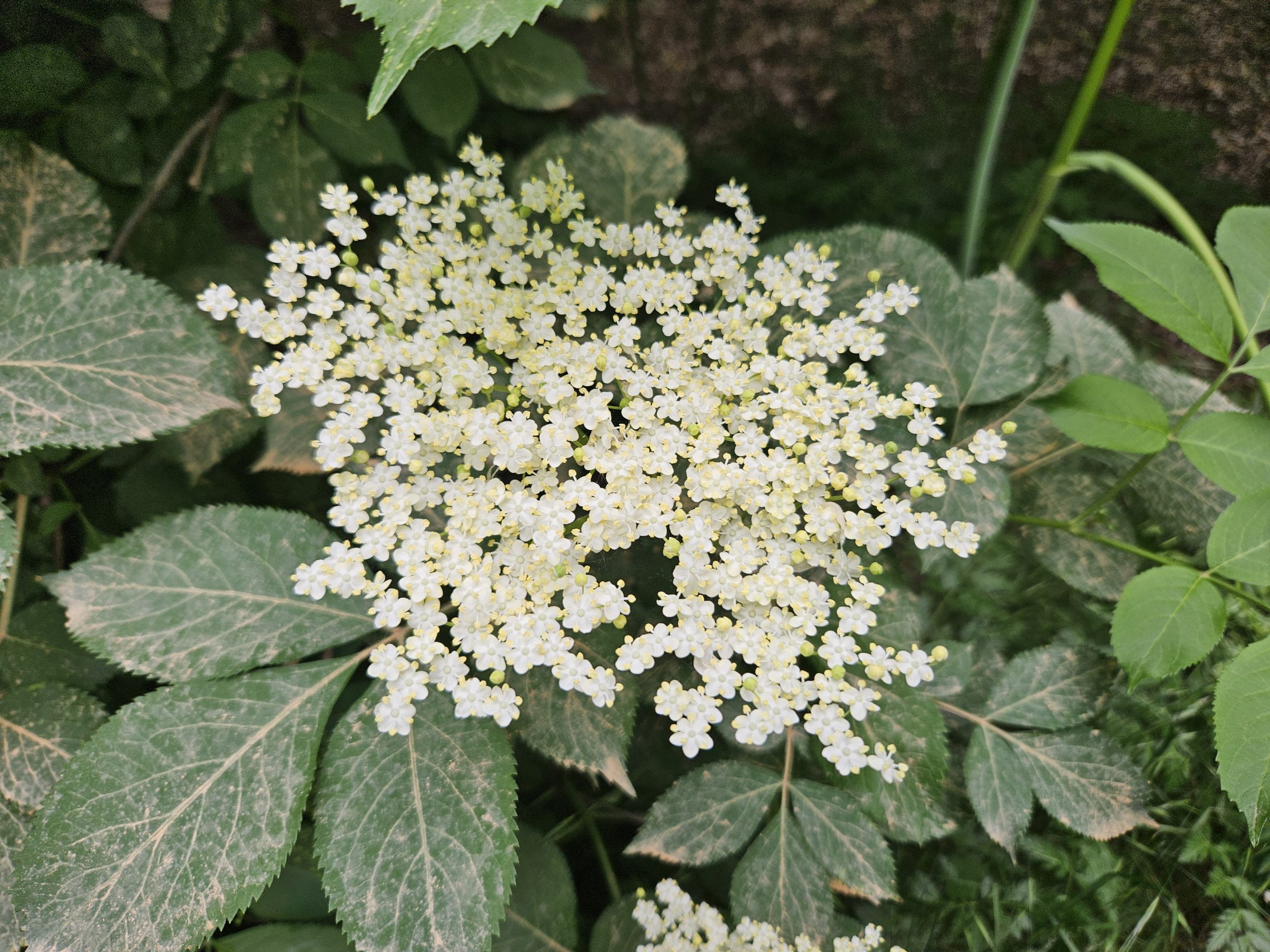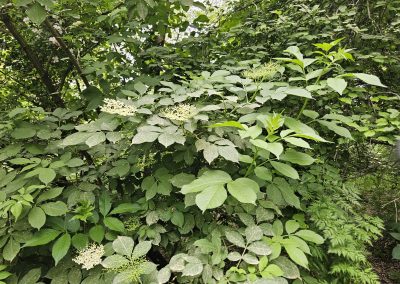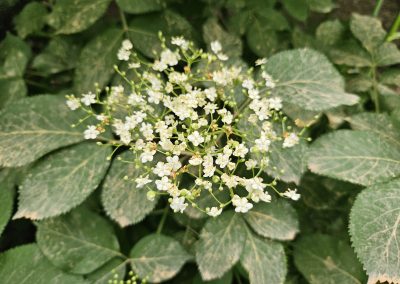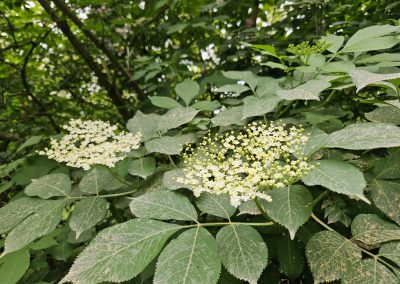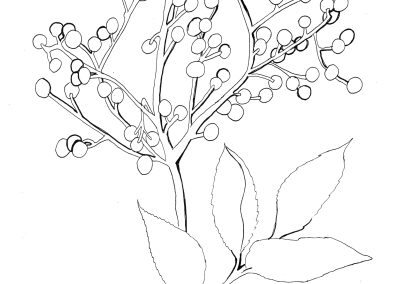Sambucus nigra
Scientific description
Sambucus nigra – Elder
Phylum: Angiospermatophyta (Magnoliophyta)
Class: Dicotyledonatae (Magnoliatae)
Subclass: Asteridae
Order: Dipsacales
Family: Caprifoliaceae
Origin: Europe – northern hemisphere
Description:
Woody shrub, 4–5 m tall, cracked rhytidome, soft white pith. Bark grey, thick, deeply ridged, branches grey. Leaves opposite, imparipinnate, 5–7 short-petiolate leaflets, acute, serrate, sparse hairs along veins on back. Flowers in cymose inflorescences, small, strongly pleasant fragrant, yellowish-white. Blooms late spring. Calyx 5 teeth, corolla 5 petals, androecium 5 stamens with yellow anthers, ovary 3 stigmas. Fruit black, shiny, baciform drupe, 3–4 seeds.
Propagation: By seed at physiological maturity and by cuttings.
Ecology:
Common in forests and bushes. Prefers sunny places with moderate humidity, resists drought and frost.
Use:
Ornamental in groups or isolated. Flowers and ripe fruits edible; other parts toxic. Inflorescences used for "socata" drink. Flowers, fruits, bark medicinal: volatile oil, sambunigrin, glycosides, mucilages; treat colds, flu, bronchitis. Syrup/juice of ripe fruit diuretic and purgative. Pith used in botany labs for plant sections.
Danger:
High toxicity, especially leaves and unripe fruits.
Sambucus nigra – Soc
Încrengătura: Angiospermatophyta (Magnoliophyta)
Clasa: Dicotyledonatae (Magnoliatae)
Subclasa: Asteridae
Ordinul: Dipsacales
Familia: Caprifoliaceae
Origine: Europa – emisfera nordică
Descrierea:
Arbust lemnos, 4–5 m, ritidom crăpat, măduvă albă moale. Scoarță cenușie, groasă, crestată; ramuri gri. Frunze opuse, imparipenat, 5–7 foliole scurt pețiolate, acute, serate, peri rari pe nervuri. Florile în inflorescențe cimoase, mici, parfumate, alb-gălbui. Înflorește primăvară târziu. Caliciu 5 dinți, corolă 5 petale, androceul 5 stamine cu antere galbene, ovar 3 stigmate. Fruct: drupă baciformă neagră, lucioasă, 3–4 sâmburi.
Înmulțire: Prin sămânță la maturitate fiziologică și butași.
Ecologia:
Specie comună, crește în păduri și tufișuri. Preferă locuri însorite, umiditate moderată, rezistă la secetă și ger.
Utilizare:
Ornamental, grupuri sau izolat. Florile și fructele coapte comestibile; restul plantei toxic. Inflorescențe pentru socată. Florile, fructele și scoarța au valoare medicinală: ulei volatil, sambunigrină, glicozide, mucilagii; tratează răceală, gripă, bronșită. Sirop/suc fructe coapte diuretic și purgativ. Măduva folosită în laboratoare pentru secțiuni de organe vegetale.
Pericol:
Toxicitate mare, mai ales frunze și fructe necoapte.
Sambucus nigra – Soc / Κουφοξυλιά
Φυλοταξία: Angiospermatophyta (Magnoliophyta)
Κλάση: Δικοτυλήδονα (Magnoliatae)
Υποκλάση: Asteridae
Τάξη: Dipsacales
Οικογένεια: Caprifoliaceae
Προέλευση: Ευρώπη – Βόρεια Ημισφαίρια
Περιγραφή:
Ξυλώδης θάμνος, 4–5 μ., ρηγματωμένο φλοιό, μαλακό λευκό ξύλο. Φύλλα αντίθετα, σύνθετα, 5–7 φυλλάρια, λογχοειδή, οδοντωτά, αραιές τρίχες στην κάτω πλευρά. Άνθη σε κυματώδεις ταξιανθίες, μικρά, αρωματικά, λευκό-κίτρινα. Άνθιση τέλος άνοιξης. Κάλυκας 5 δόντια, κόρη 5 πέταλα, ανδρόκηπος 5 στήμονες με κίτρινες ανθήρες, ωοθήκη 3 στίγματα. Καρπός: μαύρη, γυαλιστερή δρύπη, 3–4 σπόροι.
Αναπαραγωγή: Σπόροι ή μοσχεύματα.
Οικολογία:
Κοινό, φυτρώνει σε δάση και θάμνους. Προτιμά ηλιόλουστες περιοχές, μέτρια υγρασία, αντέχει ξηρασία και κρύο.
Χρήση:
Διακοσμητικό, ομάδες ή μεμονωμένα. Άνθη/ώριμοι καρποί χρησιμοποιούνται για "socată". Άλλα μέρη φυτού τοξικά. Άνθη, καρποί, φλοιός: αιθέριο έλαιο, σαμβουνιγρίνη, γλυκοσίδες, βλεννώδη, κατά κρυολογήματος, γρίπης, βρογχίτιδας. Χυμός/σιρόπι διουρητικό και καθαρτικό. Μυελός χρησιμοποιείται σε εργαστήρια βοτανικής.
Κίνδυνος:
Υψηλή τοξικότητα, ειδικά μη ώριμα φύλλα και καρποί.
Sambucus nigra – Sureau noir
Enchevêtrement: Angiospermatophyta (Magnoliophyta)
Classe: Dicotyledonatae (Magnoliatae)
Sous-classe: Asteridae
Ordre: Dipsacales
Famille: Caprifoliaceae
Origine: Europe – hémisphère nord
Description:
Arbuste ligneux, 4–5 m, rhytidome crevassé, moelle blanche. Écorce grise, épaisse, profondément striée; rameaux gris. Feuilles opposées, imparipennées, 5–7 folioles court-pétiolées, aiguës, dentées, poils rares au revers. Fleurs en cymes, petites, très parfumées, blanc-jaunâtre. Floraison fin du printemps. Calice 5 dents, corolle 5 pétales, androcée 5 étamines avec anthères jaunes, ovaire 3 stigmates. Fruit: drupe baciforme noire, brillante, 3–4 graines.
Multiplication: Par semis à maturité physiologique et bouturage.
Écologie:
Espèce commune en forêts et buissons. Préfère lieux ensoleillés, humidité modérée, résiste à sécheresse et gel.
Utilisation:
Ornementale en groupe ou isolée. Fleurs et fruits mûrs comestibles, reste de la plante toxique. Inflorescences pour boisson "socata". Fleurs, fruits, écorce: huile essentielle, sambunigrine, glycosides, mucilages, contre rhume, grippe, bronchite. Sirop/jus diurétique et laxatif. Moelle utilisée en laboratoire pour sections anatomiques.
Danger:
Toxicité élevée, surtout feuilles et fruits non mûrs.
Creative writing inspired by Sambucus nigra
The Blessing of the Elder Mother
Long ago, in a land of misty hills and deep green forests, there was a village named Wynthorpe, where the winds always carried the scent of flowers and the songs of unseen beings. At the very heart of the village grew an ancient elder tree, taller and broader than any other, known simply as The Mother Tree.
The villagers revered the Mother Tree, for they believed that the spirit of Hylde Moer, the Elder Mother, lived within its branches. They said she watched over the village, guarding it from evil spirits, disease, and misfortune. None dared to harm the tree — not a twig was broken, not a leaf was plucked — unless one first knelt before it and whispered a prayer asking for her blessing.
It was told that, long ago, a foolish man had chopped a branch without permission, and his home was later consumed by a mysterious fire. Since then, the village kept the old ways close to heart. Among the villagers was a young herbalist named Elowen, who had been raised on the stories of the Elder Mother. Elowen’s mother, now long gone, had once told her, “The elder tree is a doorway. Care for it, and it will care for you.”
One bitter winter, a strange sickness swept through Wynthorpe — fevers that no herb nor healing hand could cure. Fearing for her people, Elowen went to the Mother Tree under the cold moonlight. She knelt in the snow and whispered, "Lady of the Elder, hear me. Lend me your blessing so I may heal those in need."
As she spoke, a sudden gust of warm air brushed her cheek, and from the tree’s hollow heart, a figure emerged — a woman woven of vines and blossoms, her eyes glowing softly like stars. It was Hylde Moer herself. “You have honored me,” said the Elder Mother, her voice like the rustling of a thousand leaves. “And so, I will honor you.”
She reached into the branches and plucked a single cluster of black elderberries, glistening like tiny moons. “Brew these with care. They carry the breath of life” Elowen bowed low and, with trembling hands, accepted the gift.
Returning to the village, she crafted a potion from the berries and the elderflowers she gathered with whispered prayers. Those who drank it found their fevers breaking, their strength returning. In time, the sickness vanished as quickly as it had come.
From that day forward, the villagers planted elder trees around their homes, weaving them into hedgerows and gardens. They said the trees stood like sentinels, warding off evil, whispering blessings, and humming with unseen magic. And in spring, when the elderflowers bloomed, the people of Wynthorpe left offerings beneath the trees — bowls of milk, honey, and bread — to thank the Elder Mother who had saved them.
As for Elowen, she became known as the Blessed Herbalist, and it was said that when she walked beneath the elder trees, they bent their branches low as if to brush her hair and whisper secrets only she could hear. And thus, Sambucus nigra, the elder tree, stood forever at the crossroads of magic, myth, and medicine — a living bridge between the worlds of spirit and mortal kind.


